#how to create html tables
Explore tagged Tumblr posts
Text
The moral injury of having your work enshittified

This Monday (November 27), I'm appearing at the Toronto Metro Reference Library with Facebook whistleblower Frances Haugen.
On November 29, I'm at NYC's Strand Books with my novel The Lost Cause, a solarpunk tale of hope and danger that Rebecca Solnit called "completely delightful."

This week, I wrote about how the Great Enshittening – in which all the digital services we rely on become unusable, extractive piles of shit – did not result from the decay of the morals of tech company leadership, but rather, from the collapse of the forces that discipline corporate wrongdoing:
https://locusmag.com/2023/11/commentary-by-cory-doctorow-dont-be-evil/
The failure to enforce competition law allowed a few companies to buy out their rivals, or sell goods below cost until their rivals collapsed, or bribe key parts of their supply chain not to allow rivals to participate:
https://www.engadget.com/google-reportedly-pays-apple-36-percent-of-ad-search-revenues-from-safari-191730783.html
The resulting concentration of the tech sector meant that the surviving firms were stupendously wealthy, and cozy enough that they could agree on a common legislative agenda. That regulatory capture has allowed tech companies to violate labor, privacy and consumer protection laws by arguing that the law doesn't apply when you use an app to violate it:
https://pluralistic.net/2023/04/12/algorithmic-wage-discrimination/#fishers-of-men
But the regulatory capture isn't just about preventing regulation: it's also about creating regulation – laws that make it illegal to reverse-engineer, scrape, and otherwise mod, hack or reconfigure existing services to claw back value that has been taken away from users and business customers. This gives rise to Jay Freeman's perfectly named doctrine of "felony contempt of business-model," in which it is illegal to use your own property in ways that anger the shareholders of the company that sold it to you:
https://pluralistic.net/2023/11/09/lead-me-not-into-temptation/#chamberlain
Undisciplined by the threat of competition, regulation, or unilateral modification by users, companies are free to enshittify their products. But what does that actually look like? I say that enshittification is always precipitated by a lost argument.
It starts when someone around a board-room table proposes doing something that's bad for users but good for the company. If the company faces the discipline of competition, regulation or self-help measures, then the workers who are disgusted by this course of action can say, "I think doing this would be gross, and what's more, it's going to make the company poorer," and so they win the argument.
But when you take away that discipline, the argument gets reduced to, "Don't do this because it would make me ashamed to work here, even though it will make the company richer." Money talks, bullshit walks. Let the enshittification begin!
https://pluralistic.net/2023/11/22/who-wins-the-argument/#corporations-are-people-my-friend
But why do workers care at all? That's where phrases like "don't be evil" come into the picture. Until very recently, tech workers participated in one of history's tightest labor markets, in which multiple companies with gigantic war-chests bid on their labor. Even low-level employees routinely fielded calls from recruiters who dangled offers of higher salaries and larger stock grants if they would jump ship for a company's rival.
Employers built "campuses" filled with lavish perks: massages, sports facilities, daycare, gourmet cafeterias. They offered workers generous benefit packages, including exotic health benefits like having your eggs frozen so you could delay fertility while offsetting the risks normally associated with conceiving at a later age.
But all of this was a transparent ruse: the business-case for free meals, gyms, dry-cleaning, catering and massages was to keep workers at their laptops for 10, 12, or even 16 hours per day. That egg-freezing perk wasn't about helping workers plan their families: it was about thumbing the scales in favor of working through your entire twenties and thirties without taking any parental leave.
In other words, tech employers valued their employees as a means to an end: they wanted to get the best geeks on the payroll and then work them like government mules. The perks and pay weren't the result of comradeship between management and labor: they were the result of the discipline of competition for labor.
This wasn't really a secret, of course. Big Tech workers are split into two camps: blue badges (salaried employees) and green badges (contractors). Whenever there is a slack labor market for a specific job or skill, it is converted from a blue badge job to a green badge job. Green badges don't get the food or the massages or the kombucha. They don't get stock or daycare. They don't get to freeze their eggs. They also work long hours, but they are incentivized by the fear of poverty.
Tech giants went to great lengths to shield blue badges from green badges – at some Google campuses, these workforces actually used different entrances and worked in different facilities or on different floors. Sometimes, green badge working hours would be staggered so that the armies of ragged clickworkers would not be lined up to badge in when their social betters swanned off the luxury bus and into their airy adult kindergartens.
But Big Tech worked hard to convince those blue badges that they were truly valued. Companies hosted regular town halls where employees could ask impertinent questions of their CEOs. They maintained freewheeling internal social media sites where techies could rail against corporate foolishness and make Dilbert references.
And they came up with mottoes.
Apple told its employees it was a sound environmental steward that cared about privacy. Apple also deliberately turned old devices into e-waste by shredding them to ensure that they wouldn't be repaired and compete with new devices:
https://pluralistic.net/2023/09/22/vin-locking/#thought-differently
And even as they were blocking Facebook's surveillance tools, they quietly built their own nonconsensual mass surveillance program and lied to customers about it:
https://pluralistic.net/2022/11/14/luxury-surveillance/#liar-liar
Facebook told employees they were on a "mission to connect every person in the world," but instead deliberately sowed discontent among its users and trapped them in silos that meant that anyone who left Facebook lost all their friends:
https://www.eff.org/deeplinks/2021/08/facebooks-secret-war-switching-costs
And Google promised its employees that they would not "be evil" if they worked at Google. For many googlers, that mattered. They wanted to do something good with their lives, and they had a choice about who they would work for. What's more, they did make things that were good. At their high points, Google Maps, Google Mail, and of course, Google Search were incredible.
My own life was totally transformed by Maps: I have very poor spatial sense, need to actually stop and think to tell my right from my left, and I spent more of my life at least a little lost and often very lost. Google Maps is the cognitive prosthesis I needed to become someone who can go anywhere. I'm profoundly grateful to the people who built that service.
There's a name for phenomenon in which you care so much about your job that you endure poor conditions and abuse: it's called "vocational awe," as coined by Fobazi Ettarh:
https://www.inthelibrarywiththeleadpipe.org/2018/vocational-awe/
Ettarh uses the term to apply to traditionally low-waged workers like librarians, teachers and nurses. In our book Chokepoint Capitalism, Rebecca Giblin and I talked about how it applies to artists and other creative workers, too:
https://chokepointcapitalism.com/
But vocational awe is also omnipresent in tech. The grandiose claims to be on a mission to make the world a better place are not just puffery – they're a vital means of motivating workers who can easily quit their jobs and find a new one to put in 16-hour days. The massages and kombucha and egg-freezing are not framed as perks, but as logistical supports, provided so that techies on an important mission can pursue a shared social goal without being distracted by their balky, inconvenient meatsuits.
Steve Jobs was a master of instilling vocational awe. He was full of aphorisms like "we're here to make a dent in the universe, otherwise why even be here?" Or his infamous line to John Sculley, whom he lured away from Pepsi: "Do you want to sell sugar water for the rest of your life or come with me and change the world?"
Vocational awe cuts both ways. If your workforce actually believes in all that high-minded stuff, if they actually sacrifice their health, family lives and self-care to further the mission, they will defend it. That brings me back to enshittification, and the argument: "If we do this bad thing to the product I work on, it will make me hate myself."
The decline in market discipline for large tech companies has been accompanied by a decline in labor discipline, as the market for technical work grew less and less competitive. Since the dotcom collapse, the ability of tech giants to starve new entrants of market oxygen has shrunk techies' dreams.
Tech workers once dreamed of working for a big, unwieldy firm for a few years before setting out on their own to topple it with a startup. Then, the dream shrank: work for that big, clumsy firm for a few years, then do a fake startup that makes a fake product that is acquihired by your old employer, as an incredibly inefficient and roundabout way to get a raise and a bonus.
Then the dream shrank again: work for a big, ugly firm for life, but get those perks, the massages and the kombucha and the stock options and the gourmet cafeteria and the egg-freezing. Then it shrank again: work for Google for a while, but then get laid off along with 12,000 co-workers, just months after the company does a stock buyback that would cover all those salaries for the next 27 years:
https://pluralistic.net/2023/09/10/the-proletarianization-of-tech-workers/
Tech workers' power was fundamentally individual. In a tight labor market, tech workers could personally stand up to their bosses. They got "workplace democracy" by mouthing off at town hall meetings. They didn't have a union, and they thought they didn't need one. Of course, they did need one, because there were limits to individual power, even for the most in-demand workers, especially when it came to ghastly, long-running sexual abuse from high-ranking executives:
https://www.nytimes.com/2018/10/25/technology/google-sexual-harassment-andy-rubin.html
Today, atomized tech workers who are ordered to enshittify the products they take pride in are losing the argument. Workers who put in long hours, missed funerals and school plays and little league games and anniversaries and family vacations are being ordered to flush that sacrifice down the toilet to grind out a few basis points towards a KPI.
It's a form of moral injury, and it's palpable in the first-person accounts of former workers who've exited these large firms or the entire field. The viral "Reflecting on 18 years at Google," written by Ian Hixie, vibrates with it:
https://ln.hixie.ch/?start=1700627373
Hixie describes the sense of mission he brought to his job, the workplace democracy he experienced as employees' views were both solicited and heeded. He describes the positive contributions he was able to make to a commons of technical standards that rippled out beyond Google – and then, he says, "Google's culture eroded":
Decisions went from being made for the benefit of users, to the benefit of Google, to the benefit of whoever was making the decision.
In other words, techies started losing the argument. Layoffs weakened worker power – not just to defend their own interest, but to defend the users interests. Worker power is always about more than workers – think of how the 2019 LA teachers' strike won greenspace for every school, a ban on immigration sweeps of students' parents at the school gates and other community benefits:
https://pluralistic.net/2023/04/23/a-collective-bargain/
Hixie attributes the changes to a change in leadership, but I respectfully disagree. Hixie points to the original shareholder letter from the Google founders, in which they informed investors contemplating their IPO that they were retaining a controlling interest in the company's governance so that they could ignore their shareholders' priorities in favor of a vision of Google as a positive force in the world:
https://abc.xyz/investor/founders-letters/ipo-letter/
Hixie says that the leadership that succeeded the founders lost sight of this vision – but the whole point of that letter is that the founders never fully ceded control to subsequent executive teams. Yes, those executive teams were accountable to the shareholders, but the largest block of voting shares were retained by the founders.
I don't think the enshittification of Google was due to a change in leadership – I think it was due to a change in discipline, the discipline imposed by competition, regulation and the threat of self-help measures. Take ads: when Google had to contend with one-click adblocker installation, it had to constantly balance the risk of making users so fed up that they googled "how do I block ads?" and then never saw another ad ever again.
But once Google seized the majority of the mobile market, it was able to funnel users into apps, and reverse-engineering an app is a felony (felony contempt of business-model) under Section 1201 of the Digital Millennium Copyright Act. An app is just a web-page wrapped in enough IP to make it a crime to install an ad-blocker.
And as Google acquired control over the browser market, it was likewise able to reduce the self-help measures available to browser users who found ads sufficiently obnoxious to trigger googling "how do I block ads?" The apotheosis of this is the yearslong campaign to block adblockers in Chrome, which the company has sworn it will finally do this coming June:
https://www.tumblr.com/tevruden/734352367416410112/you-have-until-june-to-dump-chrome
My contention here is not that Google's enshittification was precipitated by a change in personnel via the promotion of managers who have shitty ideas. Google's enshittification was precipitated by a change in discipline, as the negative consequences of heeding those shitty ideas were abolished thanks to monopoly.
This is bad news for people like me, who rely on services like Google Maps as cognitive prostheses. Elizabeth Laraki, one of the original Google Maps designers, has published a scorching critique of the latest GMaps design:
https://twitter.com/elizlaraki/status/1727351922254852182
Laraki calls out numerous enshittificatory design-choices that have left Maps screens covered in "crud" – multiple revenue-maximizing elements that come at the expense of usability, shifting value from users to Google.
What Laraki doesn't say is that these UI elements are auctioned off to merchants, which means that the business that gives Google the most money gets the greatest prominence in Maps, even if it's not the best merchant. That's a recurring motif in enshittified tech platforms, most notoriously Amazon, which makes $31b/year auctioning off top search placement to companies whose products aren't relevant enough to your query to command that position on their own:
https://pluralistic.net/2023/04/25/greedflation/#commissar-bezos
Enshittification begets enshittification. To succeed on Amazon, you must divert funds from product quality to auction placement, which means that the top results are the worst products:
https://pluralistic.net/2023/11/06/attention-rents/#consumer-welfare-queens
The exception is searches for Apple products: Apple and Amazon have a cozy arrangement that means that searches for Apple products are a timewarp back to the pre-enshittification Amazon, when the company worried enough about losing your business to heed the employees who objected to sacrificing search quality as part of a merchant extortion racket:
https://www.businessinsider.com/amazon-gives-apple-special-treatment-while-others-suffer-junk-ads-2023-11
Not every tech worker is a tech bro, in other words. Many workers care deeply about making your life better. But the microeconomics of the boardroom in a monopolized tech sector rewards the worst people and continuously promotes them. Forget the Peter Principle: tech is ruled by the Sam Principle.
As OpenAI went through four CEOs in a single week, lots of commentators remarked on Sam Altman's rise and fall and rise, but I only found one commentator who really had Altman's number. Writing in Today in Tabs, Rusty Foster nailed Altman to the wall:
https://www.todayintabs.com/p/defective-accelerationism
Altman's history goes like this: first, he founded a useless startup that raised $30m, only to be acquired and shuttered. Then Altman got a job running Y Combinator, where he somehow failed at taking huge tranches of equity from "every Stanford dropout with an idea for software to replace something Mommy used to do." After that, he founded OpenAI, a company that he claims to believe presents an existential risk to the entire human risk – which he structured so incompetently that he was then forced out of it.
His reward for this string of farcical, mounting failures? He was put back in charge of the company he mis-structured despite his claimed belief that it will destroy the human race if not properly managed.
Altman's been around for a long time. He founded his startup in 2005. There've always been Sams – of both the Bankman-Fried varietal and the Altman genus – in tech. But they didn't get to run amok. They were disciplined by their competitors, regulators, users and workers. The collapse of competition led to an across-the-board collapse in all of those forms of discipline, revealing the executives for the mediocre sociopaths they always were, and exposing tech workers' vocational awe for the shabby trick it was from the start.

If you'd like an essay-formatted version of this post to read or share, here's a link to it on pluralistic.net, my surveillance-free, ad-free, tracker-free blog:
https://pluralistic.net/2023/11/25/moral-injury/#enshittification
#pluralistic#moral injury#enshittification#worker power#google#dont be evil#monopoly#sam altman#openai#vocational awe#making a dent in the universe
562 notes
·
View notes
Text
Alright, so bear with me.
Humans have three cone cells in our eyes that are how we perceive color in the world. I often think red, green, and blue, but apparently people studying them use Long, Medium, and Short to be unambiguous (just for one example, if you activate M really strongly and not L or S, the color people report seeing is yellow-green). Each type activates at different strengths to different wavelengths of light. Here's a lovely graphic from Wikipedia showing response levels of each cone type to different wavelengths:

So you can see that if some light activates L some, but not M, we'll perceive deep red, activates them both a bit, we see orange or yellow, depending on the specific amount.
It's interesting that some effect (a specific mix of pigments, or some structural coloration) could be producing some mostly 495nm light, or a blend of some slightly higher and slightly lower wavelengths, and either way we see cyan. (And a good thing, too, otherwise our display technology would be extremely unconvincing.)
Of course, then there's what happens when we get activation of L and S at once, but not M, our eye-brain systems don't infer "yellow-green", because green is specifically what's missing from there: we generate magenta, a non-spectral color. (And when all three activate we get white, of course.)
I found myself thinking about birds, with their four cones.

They're more evenly spaced too, the bastards. (These bastards are specifically finches but I'm under the impression that most birds are similar.)
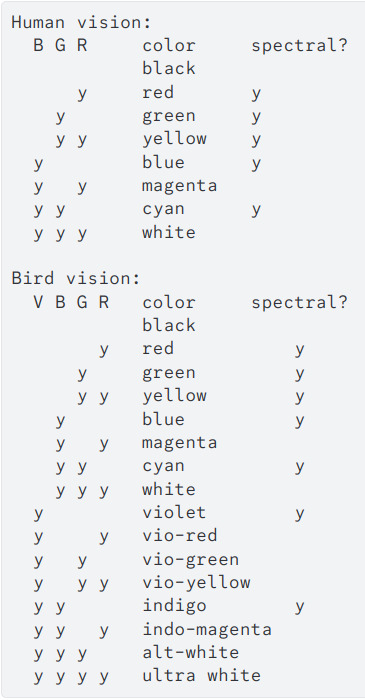
(Of course, "violet" actually means ultra-violet here. Look at the graphic, their UV cone stops responding where our S cone starts. I would edit this, but spent like half an hour discovering that tumblr doesn't support table under html or code/"preserve formatting" under markdown anymore; so you get a screencap of what I sent on discord.)
Birds could see "vio-green" (accepting name suggestions) as a color region as distinct from blue/indigo as green is from purple/magenta.
Look at that. Two whole ass independent spectral color divisions we don't have, and six non-spectral inferences. Eight whole categories of visual perception more than us. Decadent.
The heart quails to imagine what the 16 color receptors of a mantis shrimp would create. I mean, okay, it doesn't because we've studied their eyes and brains and they don't blend colors the way we do, smooshing them down to a much simpler set of perceptions.
But imagine if we rebuilt our eyes and brains for it! Color indicates chemistry, with that level of subtle blending of characteristics, would vision become like tasting everything we look at?
Please pet the bear that is with me on your way out.
#original#transhumanism#long post#I have not actually studied the perceptual systems of birds in any detail so take this with a grain of salt#regretting alt-white now that I've said it aloud in my head#edited: spat this out so fast I miswrote something under the bird spectrum image; also missed a 'd' in 'spaced'
67 notes
·
View notes
Note
GIRL CODED JASON !!!!! HI HELLO OMG TUMBLR USER AND AMAZING AO3 WRITER GHOST BIRD YOUR POSTS AND STORIES JUST ACTIVATE BRAINWORMS IN MY HEAD 😭😭😭😭 holy fuck hi I'm too shy to come off anon but I love the discussions you've been having, so just chipping in !!!
I love the many many looks on how people interpret him being girl-coded, exploring his feelings towards domestic violence, towards victims, women etc, extremely good points that you brought up ! And I'd like to bring up that on a more meta level, the way his character is treated by DC and by people in canon as a whole is also so... girl-coded ? Going to try my best to articulate since eng is my 3rd language 😔😔 Sorry if it's not consise 😭😭 I have FEELINGS AAAAAAAAAAAA
I think the core of this "girl-codedness" stems from a few things, two things I can point to currently are how he's treated as a victim and fridging. Fridging is the easier one to see imo, it's something that's usually associated with female characters but fits Jason a lot. It's not about him and his trauma/pain being feminine inherently (nothing can be categorised in that way honestly) but how it's dealt with by people and the narrative.
Let's take a look at its counterpart which is 'Dead Men Defrosting' trope coined by John Barton. Here's the source for that: https://www.lby3.com/wir/r-jbartol2.html, and a quote from the Women in Refridgerators website I feel is really encapsulates this whole situation.
"...women heroes are altered again and never allowed, as male heroes usually are, the chance to return to their original heroic states. And that's where we begin to see the difference."
Sounds familiar, doesn't it? Additionally, the grief that his death bought is made to be even more objectifying than it should have been. It's made to be Bruce's and everyone else's more than it is Jason's. The image of the dead character is, by necessity, distorted and is served as fuel towards a different character. He's reduced to his death and the pain associated with it is milked for like... 16 yearsish??? A perverted memorial, a perverted memory, an altered legacy. He was just 15. A boy. (Still, I wouldn't say Jason was fridged per say, as the term is created in reference to female characters and they have little to no agency in their stories there, but that 'feel' is there. So I understand where the girl-codedness comes from!)
It’s that the way a lot of characters treat him and a lot of the tropes used on him are things that are typically associated with feminine characters. It's also about how he's treated since he's not a perfect victim. Every attempt Jason has made to express his pain and his anger just gets him labelled as emotional, unreasonable and hysterical (which are again, unfortunately terms associated with women.)
There's many different points people have brought up about Jason, such as his bleeding compassion as Robin, the tears at the end of UTRH, and so on. Nonetheless, I think there's a lot of nuance that comes with gender discussions, since these things are deeply personal to people, and there's disagreements to be had. And that's cool !! There's many points loads of other people also being to the table that I love !! Contradictions too !!
Anyhow, so many cool PPL and analysis these days,,, ILY ANON WHO BROUGHT UP TITANS TOWER (anonanonanon pls chip in again and my life will be URS) Also ILY TUMBLR USER MAGIC-CRAZY-AS-THIS FOR PUTTING THE WEDDING DRESS IMAGERY IN MY HEAD, ALSO ILY GHOSTBIRD FOR THAT AMAZING REPLY AND ANALYSIS,, I LOVE THIS LITTLE POCKET OF COMMUNITY U HAVE CREATED this is so beloved 🥺🥺🥺💞💞💞💞
All very good points!
I don’t have much to add here except perhaps the argument with the memorial case. You’re absolutely right. I never realized how similar it is to the classic hero trope of protagonist mourning their dead love interest/family and dedicating their entire life to a memory of them, citing the actions they take to be in honor of the dead person.
On one hand, I tend to enjoy that trope. On the other hand with Jason, it all became horribly twisted so very quickly and lead to a hard downward spiral of Bruce having a real assholish phase.
But yeah that’s a whole other can of worms better left unopened for now ksksks.
I’m very happy you’re enjoying this blog 💚 it’s honestly super rewarding to hear people say that when it was one of the main goals to have this be a safe and harmonious space for everyone 💚💚✨
#ghost talks#personal opinion#by no way right or wrong just… existing#obviously it’s also to okay if someone here doesn’t like Jason at all!#totally valid#although with how much I gush about Jason very unlikely around here kskskskks#fandom and ship positivity#harmonious vibes#and a healthy approach to fiction and online interaction#batfamily
32 notes
·
View notes
Text
You know that spreadsheet I made? It's got an upgrade. Same information (with some errors fixed), but actually presentable now! Because surprisingly, it turns out that my friend, who is actually knowledgable about IT and used proper web design tools, can make a better looking site than I did by creating an Excel spreadsheet, copying the text into Notepad, adding HTML tags, and uploading the table to some free site that will let you host a single HTML page there.
Seriously, it's awesome. I'm quite enjoying looking at it. It's got a search function that lets you narrow results and actually works. All the links are still there. The text is way more readable, with things like different colours involved (I was going to put colour on my HTML page, but it seemed like too much effort to figure out).
And once again, I would like to say, to Andy Zaltzman, who came on The Bugle and announced that he'd looked up the Chocolate Milk Gang and was confused by the result: the work's been done for you, Andy! And for anyone else who wants it! No one else needs to spend dozens and dozens of hours across several years Googling this odd niche, because I've already done it! And I have a friend who knows how to do websites, so now it's even readable:
This page is going along with a larger archive that's currently under construction, but the whole thing is going to be really cool, archiving comedy is cool and useful. Although if Kitson ever manages to stumble across it, I will deny having any involvement with that archive, or, in fact, ever having heard of Kaniel Ditson.
10 notes
·
View notes
Text
webdev log uhhhh... 6?
Haven't worked on my site in a bit because I think I fucked up somewhere in during the deployment phase so now it's hard to host it locally.... only the index page works and the css is half broken anyways, presumably because of laravel breeze's tailwind coming preinstalled. I DID have to jump through hoops to get it going during deployment.. just don't know which hoops so it's stuck that way >_>;; so now I can't host it locally for development......... I'll have to make things and just hope it shows up when I deploy them I think
Failed to listen on 127.0.0.1:8000 (reason: ?)
cool, cool. thanks. very helpful debugging message..
anyways, coded up a little php doohicky and updated my site! WANNA PEEK?
I wanted to migrate my fridge page (art others have done of my characters) to my site, but I didn't want to implement another table because YUCK I'm so done with that.
I wanted something more automatic because I'm lazy and I also wanted it to not look like it's from 2003 like my neocities to match with my new site. too much trouble!!!! including the stuff previously mentioned.. so I left it untouched for a while.
then I was talking with someone and wanted to try making this with php.....

it's pretty basic. finished the code for the script in like an hour maybe, and then later it was mostly just tinkering with the html/css itself to make it display all nice and grid-like.
all it does is take all images from a specified folder and spits them out.
it creates a DirectoryIterator object to iterate through the specified folder (at least, I think that's how DirectoryIterator works.... dunno) then for each individual file it checks if it's an image, gets the time the file was modified, then stores the file path and modified time in an array. then that array gets sorted via modified time (newest first), and then iterated through and BAM...
I'd prefer a better time system such as organize when the file was actually created, but if you paste a file into a new folder, "created time" gets changed to when you pasted it.. using file modified time is the only way when you aren't using a database and just want this to be all done automatically I think. unless I'M STUPID and someone has a better idea.. then please enlighten me.
ANYWAYS added The Fridge to my site using my lil code! :>

updated my About to include a link too...
also, I was looking up things and found this funny example code on stack overflow

let's all randomize our racism images.....
6 notes
·
View notes
Text
There is something very weird about the relatively short nature of the culture surrounding website creation. As in, like, internet-user-created websites have been around for like 30-31 years at this point, and the culture surrounding them has changed so very much.
People used to create websites left and right for their own needs, their little shops and their little blogs about what they liked. Some websites of course housing horrible content since their dawn, and some being as mundane but as unique as the person behind its code. I have seen older sites, archived, that promoted creating your own site, and that was interesting to see. That culture of creating your own website and of sharing that knowledge on a still-growing facet of communication.
And then at some point social media appeared, and that was interesting, because now everyone was able to quickly present themselves without the need of a website, but that didn't mean people stopped making websites. I mean, hell, Geocities died in 2009, so a lot of people were creating their own websites for free before that time, no need to pay for domain names or hosting. And even without Geocities, there were other website hosting things that yes, while not as customizable, were still a resource for people to work with them. There's still a website floating around that I made when I was a kid using one of these services. Cool stuff.
All this to say that I do feel a weird sense of dread looking back and cross-referencing with the present and seeing things like "website creator powered by AI" and shit like that, because just ?? How did it go plummeting so quickly. There is a weird feeling of having lost a developing culture to corporations making quick access to posting things that, as corporations' nature dictates, are used to sell data or to train models or what have you. Similarly, we get pretty same-y looking pages because of the need to be slick or whatever with designs that just leaves everything looking the same. ALSO, the loss of spaces for kids, or just the gradual lowering of them in favor of cocomelons and whatever else the devil's machine has spawned is like watching an apple decay before having ripened. I do feel like there is this phenomenon in which how to make a site has been lost in the notion of "making a website falls into the realm of evil and scary coding and I could never be a programmer, plus who would look at it, plus we have tools to make them," etc etc etc. Here is a little secret: website creation is not exactly hard to pick up at all. You might say it's very similar to using a rich text editor like Word or a notes app or whatever you use. Similarly, have you used markdown for things like messages or D iscord messages, you know, with the asterisks for bold text and the likes? Markdown is based on html's structures. And truly, you do not have to even learn to code using Javascript if you don't want to, you can just go full html + css and structure your things as you go, adding your little images and your updates. Because guess what !! Html and css are not programming languages, they're a markup language and a stylesheet language respectively, which is a fancy way to say "you make the structure of your page with the first one and make it pretty with the second one". This includes cool stuff like tables, lists, grids, colors, transitions, etc. All of that without any programming. (That being said, if you are interested in programming, Javascript isn't too bad to pick up. The language itself *is* kind of evil, but using it in conjunction with html is not too difficult). I do have to say though, I am glad that there is a push to making your own websites and things, especially with Neocities sprawling a huge community of avid website creators, as well as the huge amount of tutorials and stuff making the push forward with making sites and online spaces and experiences more widely available. Hopefully this becomes a trend that keeps going up, considering the state of seemingly every single social media that has existed since the 2000s- 2010s.
#web#website#old web#dog discourse#ramblings#internet#computer#tech#but for real what the fuck#it's very bizarre to see this just pop in and out
7 notes
·
View notes
Text
launching my personal website!
finally, it is here: the website i created, powered by astro and github books!
currently featuring:
dark mode toggle
mobile friendly layouts
reader controls on my project pages
auto-generated links and layouts for new chapters in each project
css only menu drop downs & table of contents sidebar
some cool google fonts
a few of my favorite bug glyphs (mostly on desktop/tablet)!
i'll be using this website to host my personal projects, including my writing projects, comics, and perhaps a gallery of personal art unconnected to any larger theme.
roadmap:
autogenerated page descriptions in html head, for better previewing
rss feed
more commenting options
guestbook
and perhaps... more?!
come take a look at my website, i'd love to know what you think! :] you can always ask me about how i implemented features on my website -- i would more than welcome the opportunity to gab.
thanks for stopping by!
3 notes
·
View notes
Text
How do you publish a comic on ComicFury? A beginner's overview
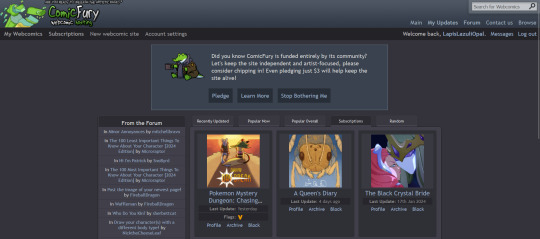
So, you're on ComicFury, see all these cool comics and think you want to make one of your own? Worry not, it's actually pretty easy :D When you have signed up, got accostumed, even subscribed to a few comics, you can go to the "new webcomic site" page to get started
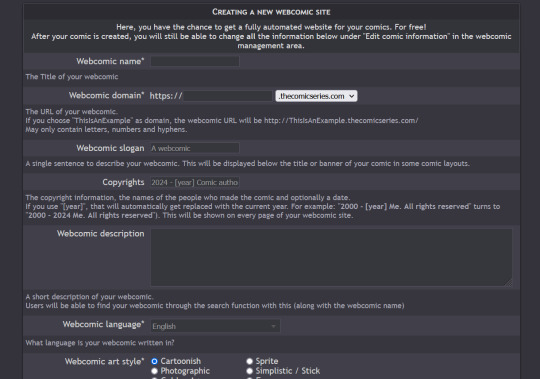
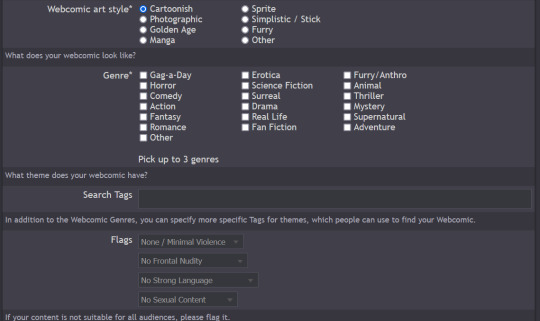
The screenshots cover the whole page, but I will summarize for you: you can chose title, description, slogan, language, style & genre, tags, content warnings and moderation settings (such as allowing comments and ratings)
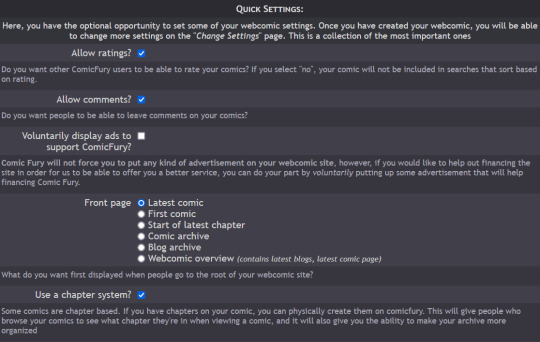

Additionally, you have five different domain options to pick from: .thecomicseries.com, .the-comic.org, .thecomicstrip.org, .webcomic.ws, and .cfw.me

Akin to tumblr's range of default themes to pick from, here you have to pick one default layout you will be able to customize later on (you can also work on the html if you're crafty enough)
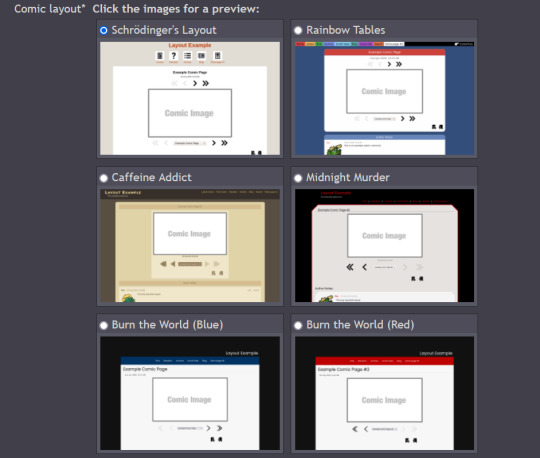
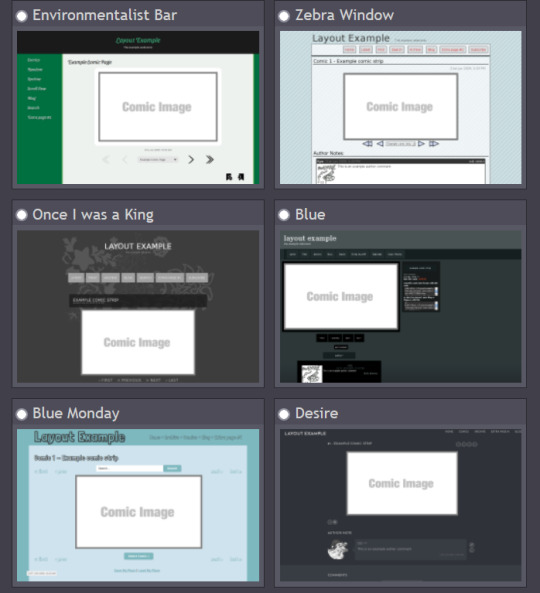
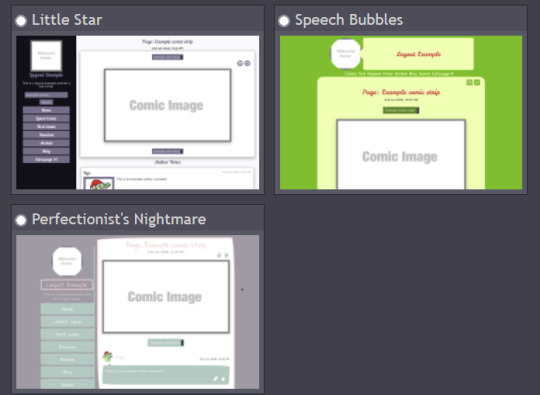
I personally picked "Rainbow Tables" because it already fits well enough the vibes of Wacky Races XD

Once you're done, you will find your webcomic or webcomics (there's no limit on how many webcomic sites you can open as far as I know) in the "My Webcomics" page. Your webcomic will have, in addition, a profile page which will be the first thing people will see when they browse on comicfury
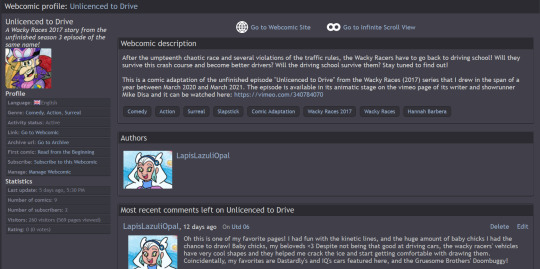
By clicking on "manage webcomic", you can do many things ranging from uploading/editing/scheduling pages to changing the website's layout
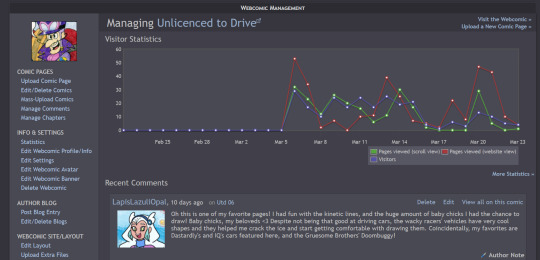
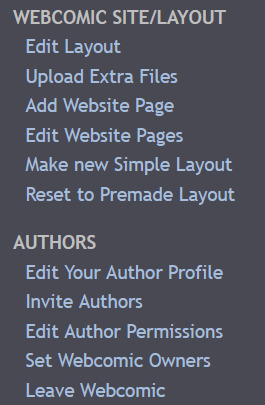
So now you want to upload some pages, right? Here we goooo
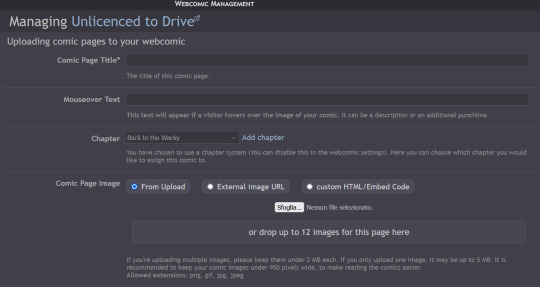
You have to pick a title for the page (could even be just Utd 01, 02 and so on), you can chose a chapter it will belong to (if you want to create chapters) then you can upload up to 12 images in the same page! But remember there's size limits: for multiple images it's maximum 2MB each, for a single image it's maxmimum 5MB. It supports png, gif, jpg and jpeg formats. After putting it some keywords that will make your comic easier to find and adding a transcript of the page if you want, you can upload your page!
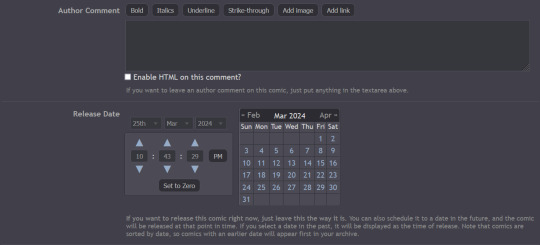

Here's how you can create chapters by clicking on "manage chapters", you pick a name and you can add a description and a cover (that's optional though) As you can see, I have five chapters on my comic for example
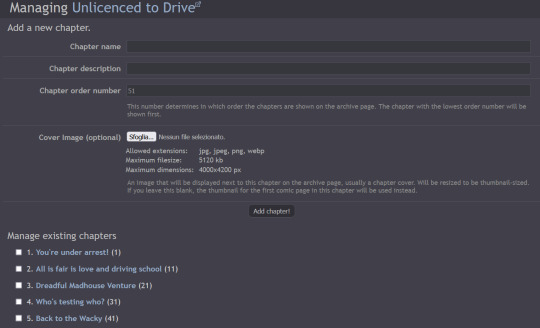
Now that you know the basis you can try it out yourself!! Mind you, it doesn't even have to be a comic, I've seen people create websites to host illustrations made for monthly challenges as well, or other webcomics can be made by photographing action figures, it can really be whatever you want! Have fun out there :D

#ComicFury#webcomics#how to use comicfury#I hope this can help anyone who wants to try out making a webcomic!#comic#webcomic#artists on tumblr#indie comics
6 notes
·
View notes
Text
How Generative AI is Changing Web Development

Introduction to AI in Web Development
Artificial Intelligence (AI) has revolutionized various industries, and web development is no exception. Generative AI, a subset of AI, leverages machine learning algorithms to automate and enhance web design and development processes. From code generation to performance optimization, AI is reshaping how websites are built, reducing development time while improving efficiency. As businesses and developers embrace AI-powered solutions, the landscape of web development is evolving rapidly. Generative AI Training
AI-Powered Code Generation for HTML, CSS, and JavaScript
One of the most significant contributions of generative AI in web development is its ability to generate high-quality code. AI-powered tools such as GitHub Copilot, ChatGPT, and OpenAI Codex can assist developers by writing HTML, CSS, and JavaScript code based on natural language prompts. These tools enable developers to:
Speed up the development process by automating repetitive coding tasks.
Reduce syntax errors and improve code accuracy.
Generate boilerplate code, frameworks, and complex logic efficiently.
AI-driven code generation is particularly useful for beginners, as it offers intelligent code suggestions and debugging support. Even experienced developers benefit from AI assistance, as it allows them to focus on higher-level problem-solving rather than routine coding tasks. GenAI Training
How AI Improves Responsive Design and Performance
Responsive web design is a critical factor in providing a seamless user experience across different devices. Generative AI plays a key role in optimizing website layouts, image scaling, and user interface adjustments by:
Automating Media Queries: AI can analyze screen sizes and device types to adjust layouts dynamically, ensuring optimal display on all screens.
Enhancing Performance: AI-powered tools can optimize images, minify CSS/JavaScript, and suggest performance improvements to enhance website speed.
Adaptive User Experience: AI can personalize web interfaces based on user behaviour and preferences, offering a more engaging browsing experience.
By leveraging AI in responsive design, developers can create adaptive websites that cater to diverse audiences, improving engagement and conversion rates.
Future Trends: Will AI Replace Frontend Developers?
As AI capabilities advance, a common question arises: Will AI replace frontend developers? While AI is undeniably powerful, it is unlikely to completely replace human developers in the foreseeable future. Instead, AI acts as an intelligent assistant, enhancing productivity and efficiency.
Here are key reasons why AI will not replace developers entirely:
Creativity and Intuition: AI lacks human creativity, which is essential for crafting unique and innovative web designs.
Problem-Solving Abilities: Web development involves more than just coding; it requires problem-solving, critical thinking, and understanding user needs.
Customization and Branding: AI-generated designs often lack the personal touch and brand identity that human designers create.
Ethical and Security Concerns: AI cannot independently handle ethical considerations, security vulnerabilities, and compliance requirements.
Instead of replacing developers, AI will continue to assist them, making web development faster, more efficient, and accessible to a broader audience.
Conclusion
Generative AI is transforming web development by automating coding tasks, enhancing responsive design, and improving performance. While AI-powered tools offer valuable assistance, they complement rather than replace human developers. The future of web development lies in collaboration between AI and developers, where AI streamlines processes, and developers bring creativity and problem-solving skills to the table. As AI technology advances, it will empower developers to build more sophisticated, user-friendly, and high-performing websites.
Embracing AI in web development is no longer optional but a necessity for staying competitive in the digital landscape. The key is to leverage AI strategically while maintaining human expertise to create the best possible web experiences.
Trending Courses: Data Science with GenAI, Prompt Eng, GenAI for DeVops,
Visit us: https://www.visualpath.in/online-gen-ai-training.html
#Visualpath#Ai#artificialintelligence#Aitraining#genai#statistics#generativeai#datascience#deeplearning#machinelearning#python#pythonprogramming#GenerativeAIDemo#education#software#student#ChatGPT#promptengineering#AIInnovation#AIFuture#TechForGood#aiart#aidesign
1 note
·
View note
Text
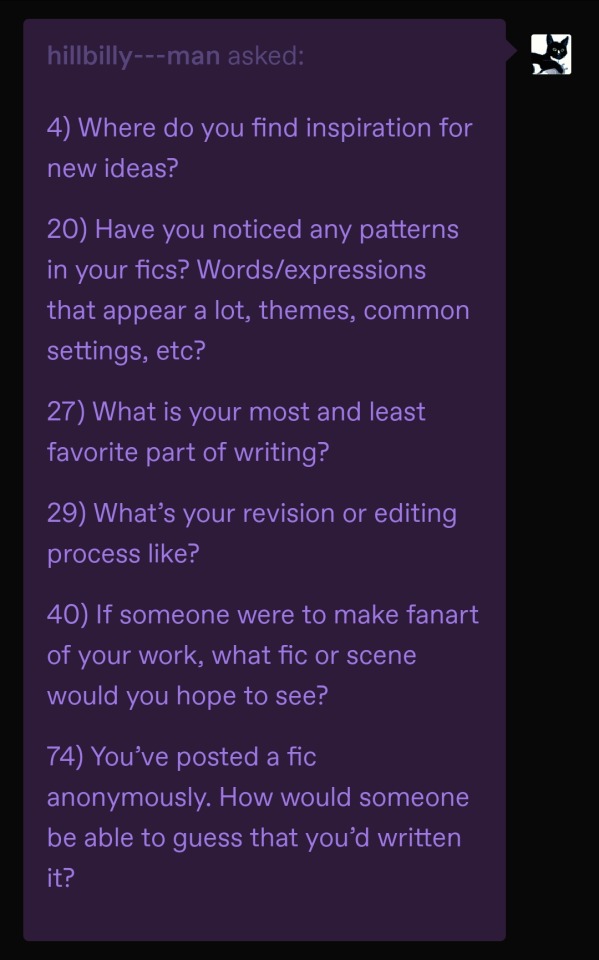
4) Where do you find inspiration for new ideas?
hsfjdlshfks I generally don't go looking for new ideas, they just break into my house and start squatting there lol. Aside from the spontaneously generated ones, I actually take a lot of inspiration from other fans! Blorbo discussions especially tend to spark interesting thoughts that lead to headcanons and stories. Sometimes fanart (all kinds) causes me to go down a different thought path than before - like, I recently saw some truly banger torisai art that changed the planned ending of a WIP lol. It's never direct inspiration though, like I genuinely wouldn't bother making something that already exists unless I thought I could bring something radically different to the table. I'm making the stuff that I wish existed but doesn't!
20) Have you noticed any patterns in your fics? Words/expressions that appear a lot, themes, common settings, etc?
Lol. Yeah all my romantic stuff is sweet and cozy and heartfelt because I'm cheesy and love that stuff. Even my most deranged lemons are super affectionate <3 I'll leave it as an exercise for the reader to call me out on other patterns lol.
27) What is your most and least favorite part of writing?
The best parts are the initial concept & brainstorming, plus writing blorbo dialogue. I'm sure it's extremely obvious that I love writing Akechi dialogue in particular – the less hinged, the better!
Worst part is the post-posting creative slump, where I've gone through all the effort of creation & posting and then there's no feedback and it just feels bad. Hate having to wait out stupid human feelings to get back to creating. It doesn't always happen (I was actually really pleasantly surprised by the reception of the toilet blog lol) but it's just a real bummer when it does!
29) What’s your revision or editing process like?
Not too intensive for me since I kinda edit as I go along. Before I get started writing, I always go over the last part (sometimes all of it), to get back in my groove, and I'll tweak it if it needs it. Once I'm done writing, if I have a beta I'll send it over, and either way I'll wait a few days before giving a final read-through and posting. Naturally a few months later I'll be reading the fic on AO3 and find typos or grammatically weird sentences, but that shit happens to professional authors too so whatever lol. Update it and carry on...
40) If someone were to make fanart of your work, what fic or scene would you hope to see?
All fanart is definitely welcome lol, but generally the romantic fics are nearer and dearer to my heart so shippy drawings inspired by my fics would have a same-type-attack-bonus on my heart!
74) You’ve posted a fic anonymously. How would someone be able to guess that you’d written it?
The CSS/HTML probably lmfaoooo.
Otherwise, probably the pairing if it's one of my captained ships, and the way I write my dialogue and don't spend any time describing shit like settings or clothing lmao.
Thanks for the ask @hillbilly---man!! 💜💜💜
[Context] <- still open for these!
6 notes
·
View notes
Text
Now that I've been on the other side of the table, I have some advice!
Do you have a friend or acquaintance who works at the company? Ask them to put in a word for you. The hiring manager will tell the recruiter to put you forward.
There are multiple assumptions here: the hiring manager has reason to trust the person who's already at the company: they know the culture, they know the team, and ultimately, they don't want to make their own job harder. A recommendation also means there's a built-in mentor who will make sure you get up to speed.
Don't know anyone? The magic words are just the things that prove you've done the job before.
Trying to get an admin role with a company that organizes events, but you've never worked for an event organizer? If you were responsible for organizing a couple major meetings at a past company, even if it was a minor duty, put it on your resume as a bullet point under that position.
The hiring manager wants to know the work isn't going to scare you away in a month. Someone who's been doing the same thing already knows what to expect. They're a safe hire because they've done the tasks that might intimidate someone else. Give them a reason to imagine you doing the tasks that need to be done.
Does the listing emphasize a personality trait or skill that seems unusual, but they haven't made it a requirement? They've probably been burned by a bad hire and just want to ensure it won't happen again.
They need someone to manage schedules, but require HTML? You'll probably be sending emails with custom HTML that someone else created, and they want to make sure they don't hire someone whose eyes will glaze over or someone who will panic when they see it come through.
That type of person likely won't take to the job, and will create problems that everyone else has to fix for them. If you've worked with custom HTML emails, add it as a bullet point. Doesn't matter if you can write your own; you can ask about it in the interview and they'll let you know the context. That gives you a chance to figure out if it's a requirement you can meet or not.
Other odd skills probably have a similar rationale.
This one sucks because it's really not for everyone, but it has to be mentioned: if you're able to, freelance. Preferably with the help of an agency who will get you gigs at multiple companies. Why?
When you apply for a permanent role, there are a few things in your favor. If the client likes your work, they're going to ask you to apply for the opening. That means you're guaranteed an interview. It also means it's going to be a very comfortable interview for you: they know you, they like your work, and they want you to work with them. It's the best case scenario!
If they don't ask you to apply--maybe there are rules against soliciting your application--they're going to still give you an interview and treat you favorably. Why? A regular freelancer already knows the culture. Already provides work output that meets the company's standards. Already fits in with the team. Already commands some level of respect. It's an extremely safe hiring decision!
And if you're with an agency that helps you get gigs at multiple companies, eventually you'll have this same best case scenario across job listings from multiple companies.
What are the magic words at the interview? It really depends. But you need to remember: they're interviewing other people, too. It's not always enough to use the magic words. If 10 people all use the magic words, why are they going to hire you instead of one of your 9 clones?
Every one of them wants the company to "just take a chance, because I need it." Why should it be you over someone just like you? No one wants to pick the nice guy anymore, amiright? If everyone is nice, then "nice" isn't the feature that's going to get you selected.
Here's the thing about interviews: they already liked your qualifications. They're assessing a few things, and a major component of that is how you say things, as much as what you say.
They want to know you're going to be able to work with the team, without being a source of conflict. i.e. They're not going to hire you if you're just going to make everyone else's job harder; that's a risky hiring decision because it might make other people leave.
Some of that you have control over. Do you have a hobby that your peers at that company likely share? If you're applying for work at an AV company, it's a safe bet that your colleagues are going to be musicians and filmmakers. Find a reason to discuss the instrument you play; they'll start comparing you, positively, to the team.
Other things will be out of your control. They may have had a past employee who made everyone miserable, and they're looking to avoid the same traits and habits. You likely won't know what that is.
But be candid. You get all this advice about making the best impression and telling them what they want to hear. But it's going to work against you. If they can't trust their impression of you, you're a risky hire. If they're looking to avoid a trait and catch you lying to hide that you behave that way, you're not likely to get a second chance at the company.
Being candid doesn't mean oversharing, though. One applicant answered a question like this, "I think it would take some adjustment, and I might be a little hesitant at first, but I think I could enjoy working in that environment."
It was about a component of our workplace culture that strongly signifies success or failure in our environment. We hired this candidate over the one who pretended it's the ideal workplace culture for them. Because we were able to get a read on what their true feelings were and how much effort it would take to ensure they adjusted well.
Also, show some awareness of how the type of role you're applying to, is structured. Is it something that's almost exclusively collaborative, or something where you'll be working alone most of the time?
Demonstrate that you're accustomed to that kind of environment. You don't need to pretend to like it. You just need to convey that you'll get the job done, and that it's not going to have you looking for something new in a couple months.
Hiring someone who must work alone, for a collaborative role, is going to make it harder for the coworkers to do their jobs; it'll cause conflict, and most likely lead to more mistakes that need to be cleaned up. In this case, the person with less work experience but who excels in a collaborative environment is the more qualified candidate.
The more you can be aware of these nuances and address them, the more likely you are to be hired.
But there's still the factor of the other candidates. You don't know who they are. Do they have more experience than you? Did they work at this company before, and came back after a growth opportunity? Did they freelance with the team previously? Are they well known from a higher position and decided to take a step back?
You can't control any of that. But they're competing with you. You can nail the interview but if a superstar employee is coming back from a growth opportunity, they're probably getting the role.
But what you can control is how you present yourself. You know how to do the job, so you should be confident. You should show that you've given thought to how the role is structured, and ask questions about the day to day job. Even little things like, "the listing says I'll be supporting a VP. Will it be the same one, or will I be assisting a few on a rotating basis?" Just ask something.
Because you're supposed to interview the company back. You like working alone? Ask about the balance between solo and collaborative tasks. You prefer working a few hours during the day, and a couple at night when it's quiet? Ask if there will be opportunities to do that. Hated a particular task in a similar role? Ask how frequently you'll need to do it in the new role.
You're going to be perceived more positively if you're honestly trying to assess if the role is a good fit for you, as much as they're trying to determine if you're a good fit for the role. Because that really is your main job at an interview: figure out if you even want this job. If they're only judging you and not vice-versa, then you didn't have the great interview you thought you did.
And here's where you should be encouraged: if you actually nail the things that are important at an interview, you could be hired over someone with more experience. I was a panelist once, for a client-facing technical role.
We interviewed people who did similar roles, but none of them made us feel confident that we could put them in front of clients. The reasons varied. Personality. Couldn't convey complex technical ideas in layman's terms. Seemed combative. Etc.
But then we had a candidate without the technical skills. They worked in a related environment that exposed them to the technical skills, so it wasn't a huge leap. Very conversational demeanor; easy to see them making a client comfortable. They could grasp the technical concepts and convey them simply. They were eager to learn. Exuded confidence. Clearly motivated. But importantly, his attitude was genuine.
He's easily one of our top performers. Now that I manage him, I'm also seeing how much he keeps growing and developing in the role.
It really came down to his ability to inspire our confidence in him. Seeing him portray the traits most valuable to the underlying goals of the role. As a candidate, that requires understanding the context more than just the duties.
You apply for 20 jobs on Indeed. The silence is deafening.
You apply for 20 jobs on Indeed. Half of them require you to create an account on the company website. You leave a trail of ghost accounts that will be used once and never again. You never receive a response.
You apply for 20 jobs on Indeed. One employer offers an interview, but it's so rare for you to receive any response that you forget to check the website and you miss the time.
You apply for 20 jobs on Indeed. One employer offers an interview, but you don't know the magic words that signal to the esoteric mind of an interviewer that you're fit for the job.
You apply for 20 jobs on Indeed. One employer e-mails you saying that 'unfortunately, you do not have the qualifications we are looking for'. You check the job again and see you applied to be a menial labourer.
You apply for 20 jobs on Indeed. Half of them require a car. No one stops to ask how you're supposed to afford one with no job.
You apply for 20 jobs on Indeed. One employer offers a job. The commute makes you want to die in your sleep.
You call the HR manager for the workplace in hopes of arranging an interview more directly. They don't even have an answering machine.
Employers complain that no one wants to work anymore.
66K notes
·
View notes
Text
Most Web Design Best Practices to Boost User Engagement Chandigarh
Ink Web Solutions provides valuable insights, inspiration, and advice to help designers and developers create stunning, functional, and user-friendly Web Designing in Chandigarh, Mohali. We design Websites that look attractive and well as responsive. Looking for web design we are here to build your website by using CSS, HTML and other technologies Reading web design blogs can help you learn about using on mobile and laptop devices. We offer services to clients at reasonable rates. Great Design is the best way to increase visitors to the website.
Make your visitors engaged design and development of the Website
After answering the questions of what your customers want and need, and how you want your company to be perceived, our Web Development Company in Chandigarh, Mohali team will create an innovative, responsive website design that stands out online. Express everything that’s important to your brand while also engaging and converting web visitors. As Web Content Accessibility Guidelines continue to evolve, it’s critical that your website is accessible. We can help you stay compliant and meet the level of accessibility required. Alongside a custom website, our Web Development team can bolster your design with a secure customer portal. Our Company designs websites using WordPress, PHP, and other technologies.
Great Homepage Design to make stunning and mobile-friendly
Corporate Homepage Design Fundamentals
We’ll get to the latest web design trends in a minute, but first, the fundamentals. These are the “table stakes” for online companies—the bare minimum for successful entry. Without these fundamentals, it will be hard for your business to earn customers’ trust and convince them to convert.
Clear Site Navigation
Visitors should be able to quickly find the information they need without confusion or more than a handful of clicks. A well-organized menu can take on a few different looks, but the core principle is that it guides users effectively through your story and sales funnel about Web Designing Company in Panchkula.

#Web Designing Company in Chandigarh#Web Designing Company in Panchkula#Web Designing Company in Zirakpur#Web Designing in Chandigarh
0 notes
Text
How to Choose the Right Technical Writing Service Provider
Whether you're launching a SaaS product, building complex machinery, or preparing regulatory documentation, one thing is certain—clear and accurate technical documentation is non-negotiable. But producing high-quality manuals, help guides, SOPs, and API docs requires more than just good writing skills. It demands structure, clarity, domain knowledge, and technical precision.
That’s why many companies turn to professional Technical Writing Services to create documentation that improves user experience, reduces support costs, and ensures compliance. However, not all service providers are created equal. So how do you choose the right one?
Here’s a step-by-step guide to help you select the best technical writing service provider for your business.
1. Define Your Documentation Needs Clearly
Before shortlisting any providers, you must understand your own requirements. Are you looking to:
Create user manuals for a new product?
Update existing documentation?
Build a developer portal with API and SDK guides?
Prepare internal SOPs or compliance documents?
Clearly defining your needs helps you filter out providers who don’t specialise in your domain or document type. It also allows you to request relevant samples and accurate quotes.
2. Look for Industry-Specific Experience
Technical writing is not a one-size-fits-all service. Writing for a healthcare startup is vastly different from documenting a cloud-based DevOps platform. Choose a service provider who understands your industry vocabulary, compliance standards, and end-user expectations.
Ask potential vendors:
Have you worked with companies in our industry?
Can you share samples or case studies?
What tools or platforms are you familiar with (e.g., Confluence, Git, MadCap Flare)?
Providers with relevant domain expertise will onboard faster and deliver better documentation from day one.
3. Evaluate Writing Samples and Style
Don’t just rely on testimonials or brochures—ask for real writing samples. When reviewing them, assess the following:
Is the content clear and logically structured?
Does it avoid jargon or explain it where necessary?
Are diagrams, visuals, or tables used effectively?
Is it task-oriented and easy to navigate?
A good technical writing sample should guide the reader with minimal confusion, even if they’re unfamiliar with the product.
4. Ask About Their Research Process
Great documentation doesn’t come from guesswork. It comes from solid research and collaboration. Find out how the service provider gathers information:
Do they interview subject matter experts (SMEs)?
Will they attend sprint or product meetings?
How do they validate technical accuracy?
The best service providers act like embedded team members—collaborating with developers, product managers, and QA teams to get the facts straight.
5. Understand Their Tools and Workflow
Ask about the tools they use for writing, collaboration, version control, and publishing. Depending on your project, they should be comfortable with platforms like:
Markdown, HTML, XML for developer docs
FrameMaker or DITA for structured writing
Jira, Trello, or ClickUp for project tracking
CMS or helpdesk integrations for content delivery
A tech-savvy writing partner saves time and integrates better into your team’s workflow.
6. Clarify Turnaround Time and Scalability
Documentation projects often evolve. Your product might expand, your team might scale, or you may need rapid turnarounds during a release sprint. Ask:
What’s your typical turnaround time for a user guide or API doc?
Can you scale up resources if our documentation needs grow?
Do you offer ongoing maintenance and versioning support?
A flexible, scalable provider will grow with your business without sacrificing quality.
7. Review Communication and Project Management
Great writing is only part of the equation. How well the provider communicates, meets deadlines, and handles feedback also matters. During the proposal phase, observe how responsive and organised they are.
You can also ask:
Who will be our main point of contact?
How do you handle change requests?
Do you provide documentation plans or timelines?
Clear communication leads to fewer revisions and smoother delivery.
Conclusion
Choosing the right technical writing service provider is not just about hiring a writer—it’s about finding a partner who understands your product, your users, and your business goals. A good provider will deliver more than documentation—they’ll deliver clarity, consistency, and a better experience for your customers and team.
If you're ready to elevate your documentation quality, reduce support load, and improve user satisfaction, explore professional Technical Writing Services that bring domain expertise, structured workflows, and content precision tailored to your needs.
0 notes
Text
Learn Full Stack Development with Mind Coders in Indore
What if learning MERN was like playing a game?
Picture this- You are just stepping into the world of coding with no clue about where to begin, how to learn full stack development. You feel underpowered. But you decided to turn that feeling into fuel and master MERN Stack. What if you could learn MERN through a fun interactive game, not textbooks? Shocking, right? Let’s dive into the world of full stack development, one level at a time.
Level 1- You enter the world of coding with the basics- HTML, CSS, JavaScript
Main Quest- Create both static and dynamic web pages.
Side Quest- Practice basic tools by making mini projects
Every game begins with learning the basics, and the same goes for full stack development. Your journey starts by building a strong foundation with essential tools like HTML, CSS, and JavaScript. These foundation tools teach you how to structure web pages, make the pages visually appealing and make them interactive.
HTML- It is the fundamental framework of a website.. It sets the structure of a document with elements such as headings, tables, links, images etc.
CSS-CSS - This is the place where your imagination turns into reality. Just like how you would want to customize your character with various skins in your game, you can change the look and design of your web page from colour schemes to animation.
JavaScript- It is the brain behind a web page. It brings logic to your game and makes it interactive for the users.
Together, these tools act as the ‘starter kit’ every developer should master before moving on the next level.
Level 2- Building the Magic Behind the Games with Node.js and Express.js
Main Quest- Build dynamic APIs
Side Quests- Create and implement reliable APIs to interface with your frontend and database.
Once you've learnt the basics, you progress to the next stage of your programming adventure — the starting level of the game.Here, you experience the magic of server side languages to help you run your website smoothly. It includes-
Node.js-
Engage in practical experience with processing HTTP requests, constructing servers, and overseeing asynchronous tasks — the core principles of contemporary backend development.
Node.js provides a cohesive JavaScript environment for both client-side and server-side development — an essential component of the MERN stack.
Express.js-
Master the creation of routes, API development, and middleware integration.
Gain insight into organizing your server application: arrange routing, data processing, and error handling for more organized, maintainable code.
Express.js converts your Node server into a backend ready for production—scalable, adaptable, and effective.
Level 3- The Place where all the Data is stored with MongoDB
Main Quest- Connect your websites to MongoDB
Side Quest- Perform CRUD operations
After successfully completing the first map, we move to the second map- the place where the player's data are stored. It contains every important information about the player including their achievements, the amount of time they played, scores etc. Similarly, a database like MongoDB stores all the necessary information of users. You will understand the basic concepts of MongoDB, including:
Ways to apply the concepts of CRUD (Create, Read, Update, and Delete) functions.
Employing MongoDB for the storage and retrieval of user information.
Understanding how an app remembers users, content and interactions.
After the successful completion of this level, you will learn how to integrate and manage a powerful NoSQL database.
Final Level- building and Deploying your Full stack Apps and Websites
When you reach the final level of the game, you have done it all- from front-end and back-end development to storing and managing level. Now you will face the final boss where everything comes together. Here you will build real world web applications combining React( frontend), Node & Express( backend) and MongoDB(database) into a seamless web app. You will also debug real-world issues to optimize your web app’s performance.
This hands-on project will act as your stepping stone into the world of web development.
What Makes Mind Coders MERN stack course Different?
Live Project Training- At Mind Coders, our industry experts teach students how to build projects in class, which includes building a Chat App, an E-Commerce Store, a Dynamic Portfolio and a Blog Platform.
Taught by Industry experts- Our courses are taught by industry experts with years of experience in their field to provide you the right support and guidance in order for you to stand out.
Industry Driven Curriculum- Our Course is structured to match the needs of today’s job market. It is created by industry experts, ensuring the students gain knowledge from their experiences.
How to Enroll in the MERN Stack Course at Mind Coders?
Visit: https://www.mindcoders.in/courses/mern_stack_course_in_indore
Contact us:+91 076740 40233
Visit our Institute- 206, Pearl Business park, opposite I Bus stop, Indore, Madhya Pradesh,452014
Ready to start your coding experience?
Transform your coding experience into an extraordinary quest with our MERN Stack course. Whether you’re a novice grasping your initial weapon (HTML) or an expert prepared to tackle the ultimate challenge (full-stack deployment), we’ll assist you through each stage. Join Mind Coders and begin creating genuine web applications — one mission at a time.

0 notes
Note
I'm not sure about how Notion works, beyond what I have just read in this post. But I feel that the principles of this method could be adapted to other writing software. In my case, it could be adapted to Obsidian.
How I imagine that happening is that one creates a table within a note in Obsidian with the same columns as what is described, then simply create new notes that are linked to the names in the table. Obsidian also has the ability to allow for the rearranging of rows and columns as well as html support to customize the table as a whole.
Hello!! I hope you're having a good day ^^ I came across your post about writing non-linearly on Notion and I'm excited to try it out because the advice resonated with me! Though, I'm really new to using the app and, if possible, need help with how to do this part: 'where every scene is a separate table entry and the scene is written in the page inside that entry.' ;v;
Hello! Thank you so much for messaging!!! Since that post about writing non-linearly (linked for context) blew up roughly ten thousand times as much as anything I've ever posted, I've been kind of meaning to make a followup post explaining more about how I use Notion for writing non-linearly, but, you know, ADHD, so I haven't done it yet. XD In the meantime, I'll post a couple screenshots of my current long fic with some explanations! I'd make this post shorter, but I'm unable to not be Chatty. XD (just ask my poor readers how long my author notes are...) (There is a phone app as well which syncs with the desktop/browser versions, but I work predominantly in the desktop app so that's what I'm gonna be showing)
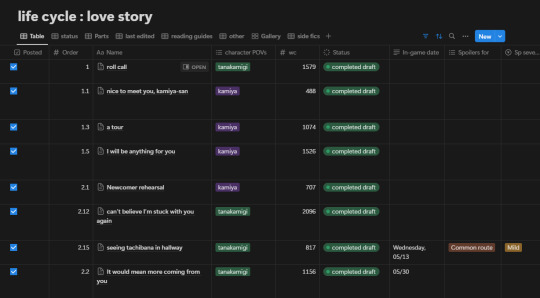
(the table keeps going off the right side of the image but it's a bunch of unimportant stuff tbh) So this is more complicated than what you'll probably start with because I'm Normal and add a bunch of details that you might not need depending on what you're doing. For example, my fic switches POVs so I have a column for tracking that, and my fic follows a canon timeline so I have a column for dates so I can keep track of them, and I also made columns for things like if a scene had spoilers or certain content readers may want to avoid, which they can access in my spoiler and content guide for the fic. (As I said, I'm Normal.) I also do some complicated stuff using Status and estimated wordcount stuff to get an idea of how long I predict the content to be, but again, not necessary. Anyway, you don't need any of that. For the purposes of this explanation, we're just gonna look at the columns I have called Name, Order, and Status. (And one called Part, but we'll get into that later) Columns in Notion have different types, such as Text, Numbers, Select, Date, etc, so make sure to use the type that works best for the purpose of each column! For example, here I'm using Select for Character POVs, Number for Order and WC (wordcount), and Text for the In-Game Date. Okay let's get into it! Name is a column that comes in a Notion table by default, and you can't get rid of it (which drives me up the wall for some purposes but works totally fine for what we're doing here). As you can see on the scene I've labeled 'roll call', if you hover over a Name entry, a little button called 'Open' appears, which you click on to open the document that's inside the table. That's all default, you don't have to set anything up for it. Here's a screenshot of what it looks like when I click the one titled 'I will be anything for you' (I've scrolled down in the screenshot so you can see the text, but all the data fields also appear at the top of the page)
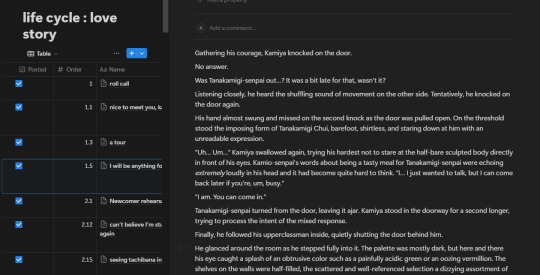
(This view is called 'side peek' meaning the document opens on one side and you can still see the table under it on the left, which is what mine defaults to. But you can set it to 'center peek' or 'full page' as well.) All my scenes have their own entry like this! Note that I've said scenes, not chapters. I decide the chapters later by combining the scenes in whatever combination feels right, which means I can often decide in advance where my chapter endings will be. This helps me consciously give most of my endings more impact than I was usually able to do when I tried to write linearly. So hopefully that gives you an idea of what I mean by writing inside the table and treating the table as a living outline. The 'Status' column is also pretty straightforward, and might require a little setup for whatever your needs are. This is another default column type Notion has which is similar to a Select but has a few more specialized features. This is how mine is set up:
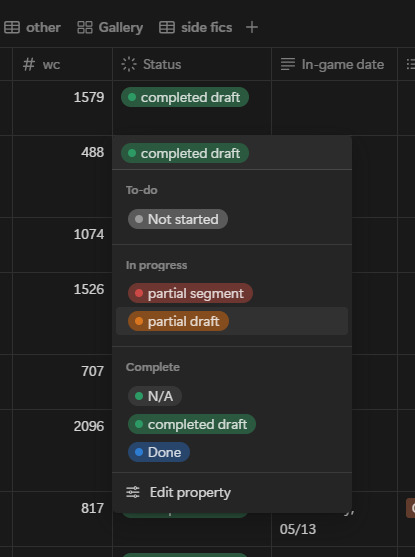
(I don't actually use 'Done', idk why I left it there. Probably I should replace it with 'Posted' and use that instead of the checkmark on the far left? whatever, don't let anyone tell you I'm organized. XDD)
Pretty straightforward, it just lets me see easily what's complete and what still needs work. (You'll notice there's no status for editing, because like I mentioned in my other post, I don't ever sit down to consciously edit, I just let it happen as I reread) Obviously tailor this to your own needs! The Order column is sneakily important, because this is what makes it easy for me to keep the scenes organized. I set the Sort on the table to use the Order to keep the scene ordered chronologically. When I make the initial list of scenes I know the fic will have, I give all of them a whole number to put them in order of events. Then as I write and come up with new scene ideas, the new scenes get a number with a decimal point to put them in the spot they fit in the timeline. (you can't see it here, but some of them have a decimal three or four digits deep, lol). Technically you can drag them to the correct spot manually, but if you ever create another View in your table (you can see I have eight Views in this one, they're right under the title) it won't keep your sorting in the new View and you'll hate yourself when it jumbles all your scenes. XD (And if you get more comfortable with Notion, you probably will at some point desire to make more Views) The Part column isn't necessary, but I found that as the fic grew longer, I was naturally separating the scenes into different points along the timeline by changes in status quo, etc. (ex. "this is before they go overseas" "this is after they speak for the first time", stuff like that) in my mind. To make it easier to decide where to place new scenes in the timeline, I formalized this into Parts, which initially I named with short summaries of the current status quo, and later changed to actual titles because I decided it would be cool to actually use them in the fic itself. Since it's not in the screenshots above, here's what the dropdown for it looks like:
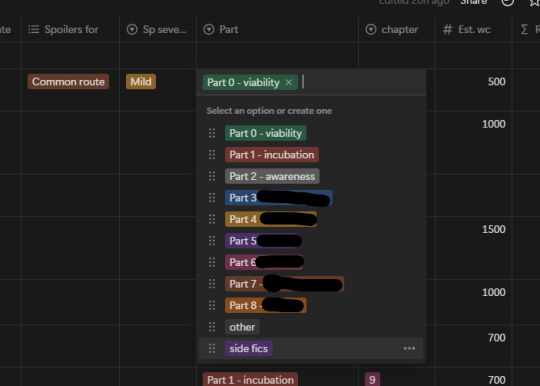
(I've blocked some of the titles out for spoiler reasons)
Basically I only mention the Parts thing because I found it was a useful organizational tool for me and I was naturally doing it in my head anyway. Anyway, I could keep talking about this for a really long time because I love Notion (don't get me started on how I use toggle blocks for hiding content I've edited out without deleting it) but that should be enough to get started and I should really, you know, not make this another insanely long post. XDD And if anybody is curious about how the final results look, the fic can be found here.
#writing#writing advice#fiction writing#fic writing#fanfic writing#fanfiction writing#writing resource#writing resources#writeblr#writers on tumblr#fanfic#fanfiction#fiction#fic
574 notes
·
View notes
Text
Published on YouTube: Last Seat at the Table: Episode 2
Published on YouTube: Last Seat at the Table: Episode 2 https://jefreydelton.blogspot.com/2025/06/published-on-youtube-last-seat-at-table_24.html Join this channel to get access to perks: https://www.youtube.com/channel/UCrb3yBN6s5mjfbiJMTpa4dg/join Leah's act of **hope** creates a ripple effect, reminding us of **God's** unending **love**. This **Christianity**-themed video is a **thought-provoking story** that shows how simple acts of kindness can change everything. Please watch the full video... Dive into these **deep bible stories** and explore the messages within. Join Father Mike Schmitz in this **bible study** as he gives a powerful **sermon**. Experience **christianity** in a new light. Let the words inspire **hope** and guide your path. Christian stories, gospel short films, heartwarming Christian films, 30-minute Christian story, forgiveness story, redemption movie, faith-based videos, Christian inspiration, Bessie Nova stories, real-life Christian drama Christian short film Christian inspirational story Gospel movie Faith-based film Heartwarming Christian story Jesus story movie Christian drama movie Story about God True Christian story Christian movie 2024 Forgiveness Christian movie Bible-based movie Christian message short film Uplifting Christian video Powerful story about Jesus Christian movie for family Life changing Christian story Christian testimony video God’s love short film Christian film full movie #ChristianStory #FaithBasedFilm #ChristianMovie #GospelMovie #ChristianShortFilm #JesusStories #GodIsGood #ChristianDrama #BibleBased #InspiringFaith #TrueChristianStory #HeartwarmingFaith #ChristianInspiration #StoriesOfGrace #ChristianTestimony #FaithInAction #GodsLove #HopeInChrist #ChristianMotivation #LightOfChrist Forgiveness stories Angels in disguise Christian youth dramas Modern-day parables? Thank you for watching this heart-touching story from Bessie Nova. If this tale moved you, inspired you, or made you believe in God again... Please LIKE, SUBSCRIBE, and SHARE this story with someone who needs it today. 🔔 Turn on the notification bell so you never miss a powerful new bible-inspired story. 💬 And tell us in the comments: Have you ever met someone who changed your life in the most unexpected way? At Bessie Nova, every story holds a lesson... And every heart deserves to be seen. ❤️ ➕ Subscribe now and discover the stories the world needs to hear. Last Seat at the Table: Episode 2 published first on https://www.youtube.com/@BessieNova / from Bessie Nova https://bessienova.blogspot.com/2025/06/published-on-youtube-last-seat-at-table_24.html via https://www.youtube.com/@BessieNova via Jeffrey Dalton https://jefreydelton.blogspot.com/ June 24, 2025 at 06:06AM
0 notes